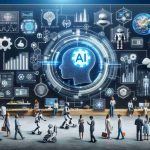Recent advancements in artificial intelligence (AI) are reshaping the landscape of scientific research, posing new challenges for traditional artists and writers. Scientists believe that AI could dramatically influence research methodologies and might lead to nominees for prestigious awards like the Nobel Prize.
In 2021, researcher Hiroaki Kitano introduced an ambitious initiative titled the Nobel Turing Challenge. This initiative calls on scientists to create an autonomous AI capable of conducting research worthy of a Nobel distinction by 2050. A significant number of researchers are dedicated to this endeavor, with reports indicating that there are around a hundred robotic scientists already operating in various scientific fields.
Ross D. King, a professor specializing in AI at Chalmers University in Sweden, noted that such developments are rooted in pioneering work. Back in 2009, King and his team introduced “Adam,” a groundbreaking robot designed to make independent scientific discoveries. This machine was programmed to autonomously generate hypotheses, conduct experiments, and learn from the outcomes.
Moreover, a follow-up project produced another robotic scientist, known as “Eve,” which focuses on investigating malaria treatments and other tropical diseases. As AI continues to transform scientific practices, experts emphasize its potential to reduce research costs and enhance efficiency. However, they acknowledge that AI has yet to match human scientists in terms of understanding complex scenarios, suggesting a collaborative future rather than a complete replacement.
Exploring the Intersection of AI and Research: Tips, Hacks, and Fascinating Insights
As artificial intelligence (AI) continues to revolutionize various fields, including scientific research, it’s essential to stay informed about its evolving role and implications. Here are some tips, life hacks, and interesting facts that will help you navigate this fast-changing landscape.
1. Leverage AI Tools for Research Efficiency
AI-powered tools can streamline the research process. Software like IBM Watson helps researchers analyze vast amounts of data quickly, enabling them to generate insights faster than traditional methods. Use these tools to identify trends and patterns that would be difficult to discern manually.
2. Collaborate with Your AI
Rather than viewing AI as a competitor, consider it a collaborator. For instance, by using AI to handle repetitive tasks, researchers can focus on creative aspects of their work. Look into programs like “Adam” and “Eve” that have demonstrated the practicality of robotic scientists, and encourage collaboration by integrating some of their methodologies into your own research.
3. Stay Updated on AI Research Initiatives
Subscribe to newsletters or follow leading AI research institutions to keep up with the latest developments. The Nobel Turing Challenge, for example, aims to produce autonomous AI capable of earning Nobel distinctions by 2050. Staying updated will allow you to understand emerging trends and possibly collaborate on cutting-edge projects.
4. Apply AI to Broader Scientific Applications
AI’s potential extends beyond traditional research. Explore its applications in fields like environmental science, healthcare, and engineering. AI can optimize processes in these areas, from predicting ecological changes to developing new treatment plans.
5. Use AI to Enhance Your Learning
AI can personalize education and enhance your understanding of complex subjects. Consider platforms that adapt to your learning pace and style, making it easier to grasp difficult topics in science and technology.
6. Utilize AI for Creative Projects
If you’re an artist or writer, experiment with AI-driven tools to inspire your creative projects. AI can generate ideas, suggest themes, or even compose music. Use AI to augment your creativity, exploring new styles or themes you might not have considered.
Interesting Fact: The Current State of Robotic Scientists
There are approximately one hundred robotic scientists operating today, conducting research across various fields. This number is expected to grow as technology advances and more researchers embrace AI in their work.
Another fascinating aspect is the focus on AI’s limitations. While machines can process and analyze data with remarkable speed, they currently lack the nuanced understanding that human scientists possess. This opens the door for future collaboration between humans and machines, creating a synergistic environment where both can thrive.
By embracing these tips and staying informed, you’ll be better equipped to navigate the rapidly evolving intersection of AI and scientific research. For more on the future of AI and its applications, visit MIT Technology Review.






















